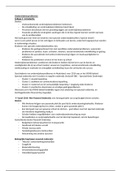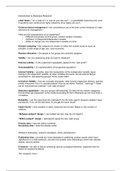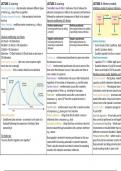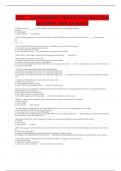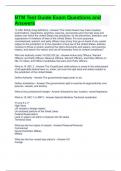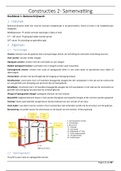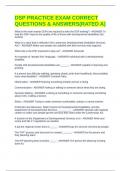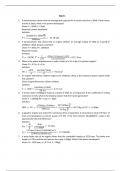Supply chain (SC) = all parties involved in fulfilling a customer demand. It is dynamic and involves
the continuous flows of information, product, and funds between stages.
Objective of the SC → maximize overall value generated ⇒ supply chain surplus = Customer Value
– Supply Chain Cost.
Supply chain profitability = the revenue generated from the customer - overall cost across the
supply chain.
- SC cost = consumers value-price + price
Effective supply chain management = involves the management of supply chain assets and product,
information, and fund flows to maximize total supply chain surplus.
Supply chain flows = Funds, information, products
🚦Easy to remember the flows with FIP →
Decision phases in a supply chain( plays significant role in success or failure)
I. Supply Chain Strategy or Design: how to structure the supply chain over the next several
years.
A. Goal = maximize supply chain surplus
B. what configuration?
C. How to allocate resources?
D. What process will each stage perform?
II. Strategic decisions:
A. Whether to outsource or perform a supply chain function
in-house
B. The location and capacities of production and warehousing facilities
C. The products to be manufactured or stored at various locations
D. The modes of transportation to be made available along different shipping legs, and
the type of information system
III. Supply Chain Planning:
A. Decision for the next quarter or year
predicting future demands
B. How much should have in stock, forecast of costs and prices
companies define a set of operating policies that govern short-term operations
IV. Supply Chain Operation:
A. Daily or weekly operational decisions
B. Goal= handle incoming customers orders in best possible way
, C. optimize performance and exploit the reduction of uncertainty
decisions regarding individual customer orders
firms allocate inventory or production to individual orders
set a date by which an order is to be filled
D. generate pick lists at a warehouse, allocate an order to a particular shipping mode
and shipment, set delivery schedules of trucks, and place replenishment orders.
Short term → meaning that there is not much uncertainty
V. Planning decisions:
A. The goal is to maximize the supply chain surplus over the planning horizon.
B. Which markets will be supplied from which locations, Subcontracting, backup
locations,Inventory policies
C. Timing and size of market promotions.
In planning decisions demand uncertainty, exchange rates, competition over the
time horizon must be considered.
VI. Operation:
A. Time horizon is weekly or daily.
B. Supply chain configuration is fixed and operating policies are determined.
C. Operation decisions: Allocate orders to inventory or production,Set delivery
schedules, Much less uncertainty (short time horizon).
Process views of a supply chain
Cycle view Push/Pull view
The processes involved and the owners of each process. Processes based on whether they are initiated in
This view is useful when considering operational response to a customer order (pull) or in
decisions because it specifies the roles and responsibilities anticipation of a customer order (push). This view
is useful when considering strategic decisions
of each member of the supply chain and the desired
relating to supply chain design. The goal is to
outcome for each process identify an appropriate push/pull boundary such
that the supply chain can match supply and
demand effectively.
Elements:
1. Customer order cycle - between the customer and
retailer
2. Replenishment cycle - between the retailer and
the distributor or wholesaler
3. Manufacturing cycle - manufacturer or repair
activity and the next downstream member of the
supply chain. This next downstream member may
be a wholesaler, a retailer, or the customer.
4. Procurement cycle- between the manufacturer
and supplier
, Question: What is the effect of having more pull rather than push processes in a supply chain?
You have to customize the products, which means higher costs.
👀Application of theory (AOT):
- Sugar cubes: push , demand is predictable , consumption is forecasted.
- Aircrafts or suits: can be both. depends on strategy
- Laptop: can be customized, so pull.
Both process views can be divided into 3 macro processes= Supply Chain macro processes in a firm
←crucial for successful supply chain management
1. Customer relationship management(CRM): all processes at the interface between firm and its
customers
2. Internal supply chain management(ISCM): all internal processes
3. Supplier relationship management(SRM): all processes between firm and supplier
👀Application of theory( AOT):
These examples apply to process views.
Zara
● highly responsive to changes with affordable prices: they are pushing to the market. (Push
view) and forecasting.
● cycle time(complete operation) of 4-6 weeks.
● Manufacturer: in Europe and Asia(less than most clothing stores).
● Predictable demand in Asia, less predictable in Europe.
Give an example of a short supply chain without some of the process view stages?
Answer: farms who directly sell products
Amazon:
Started by filling all orders using books purchased from a distributor in response to customers
orders--push/pull view
● Later added warehouses , to respond quicker
● acquisitions of Zappos→ added more variety
● Also acquired DIAPERS.COM→ did not increase variety
● Expanded online sells ( cheaper than shipping)


